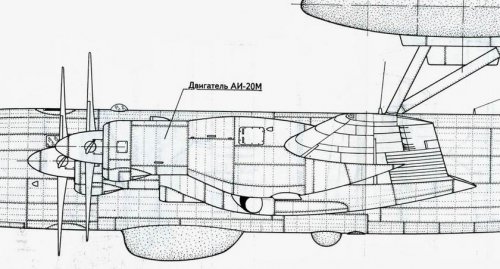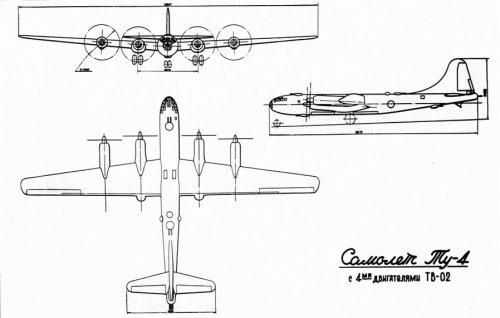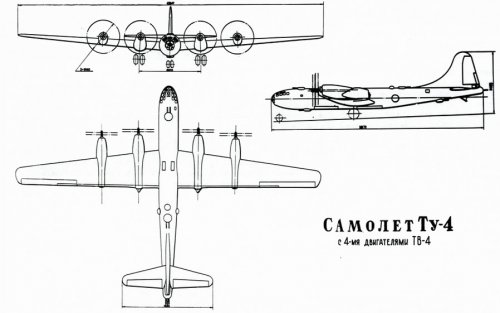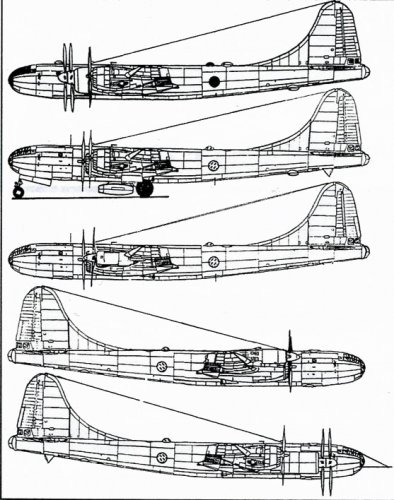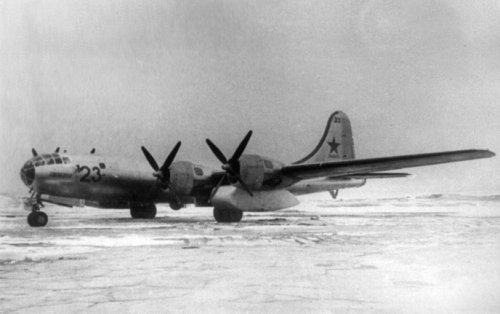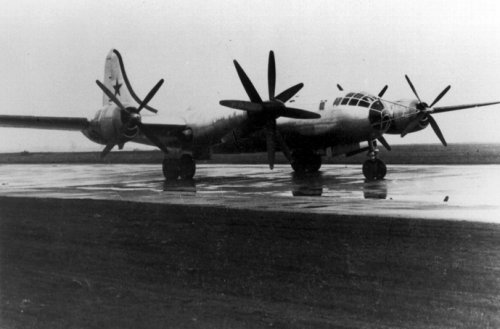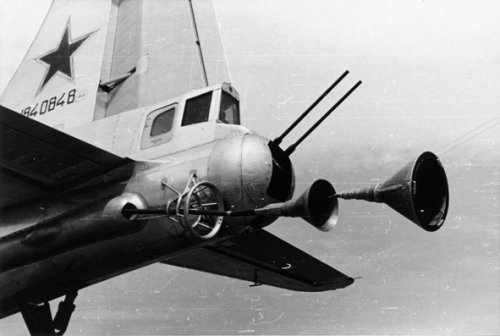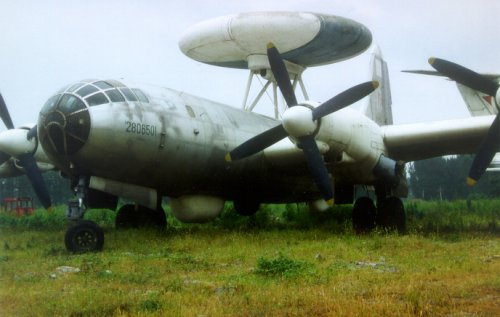I've been reading in various sources recently about the PRC Tu-4s modded with the turboprops. We all, I guess, know about the drone carrier & AWACS & I've read some indication that the conversion goes back to the '70s for the standard bomber version, I guess the drone carrier being closest to that. However, I've not found any performance data & I'm curious as to that. I don't know how the weights of the piston engines compare to these turboprops, but they are about twice the power of the recips & appear a cleaner (less drag) installation combined with the additional exhaust thrust, surely the a/c would have been a screamer, not to mention climbing like a bat out of Hades along with greatly reduced ground roll & probably no payload weight limit. Anyone ever seen or heard what its performance was? Or, any of you engineering types have a thought? My limited knowledge & guesstimate of turboprop mods in general it oughta be able to hit about 500 MPH, but I also don't know the airframe limitations, in addition to climbing like that aforementioned bat & other guesstimates. Thanks.
You are using an out of date browser. It may not display this or other websites correctly.
You should upgrade or use an alternative browser.
You should upgrade or use an alternative browser.
PRC Tu-4 w/ WJ-6(?) AI-20 turbo props performance Q
- Thread starter frank
- Start date
- Joined
- 25 July 2007
- Messages
- 4,152
- Reaction score
- 3,795
Frank,
I suspect that you're right about a 500 mph top speed. After all, the corpulent An-12 Cub can hit 482 mph (777 km/h) on similar engines.
The original Tu-4 is a much heavier aircraft [Tu-4 empty weight: 77,594 lb / 35,270 kg vs An-12 62,000 lb / 28,000 kg]. But considerable weight loss must have been accomplished just by removing the gun turrets, bomb racks, etc.
You asked about comparative engine weights. Empty weight of the original ASh-73TK radial was 2,987 lbs / 1,355 kg. Empty weight for a AI-20M turboprop (or Zhuzhou Wojiang-6 equivalent *) is 2,376 lbs / 1,080 kg.
So, reckon on a further 2,444 lbs / 1,110 kg in engine weight saved. That's 4 x 611 lbs / 277 kg difference between the empty weights of ASh-73TK and AI-20/WJ6.
[* The Kong Jiang-1 AEWC may well have Zhuzhou Wojiang-6s with BPF props. But, I think we can assume that earlier Tu-4 conversions had AI-20Ks or AI-20Ms with Stupino props. In any case, the dry weight for the WJ6 should be identical to an AI-20.]
I suspect that you're right about a 500 mph top speed. After all, the corpulent An-12 Cub can hit 482 mph (777 km/h) on similar engines.
The original Tu-4 is a much heavier aircraft [Tu-4 empty weight: 77,594 lb / 35,270 kg vs An-12 62,000 lb / 28,000 kg]. But considerable weight loss must have been accomplished just by removing the gun turrets, bomb racks, etc.
You asked about comparative engine weights. Empty weight of the original ASh-73TK radial was 2,987 lbs / 1,355 kg. Empty weight for a AI-20M turboprop (or Zhuzhou Wojiang-6 equivalent *) is 2,376 lbs / 1,080 kg.
So, reckon on a further 2,444 lbs / 1,110 kg in engine weight saved. That's 4 x 611 lbs / 277 kg difference between the empty weights of ASh-73TK and AI-20/WJ6.
[* The Kong Jiang-1 AEWC may well have Zhuzhou Wojiang-6s with BPF props. But, I think we can assume that earlier Tu-4 conversions had AI-20Ks or AI-20Ms with Stupino props. In any case, the dry weight for the WJ6 should be identical to an AI-20.]
1)-2) - Tu-4 (AI-20M)
3) – “Aircraft – 94” Tu-4 (TV-2)
4) – “Aircraft – 94” Tu-4 (TV-4)
Sources: “AviO’4”
“Aviation Cosmonautics #17
V.Rigmand "Strategic twins"
3) – “Aircraft – 94” Tu-4 (TV-2)
4) – “Aircraft – 94” Tu-4 (TV-4)
Sources: “AviO’4”
“Aviation Cosmonautics #17
V.Rigmand "Strategic twins"
Attachments
"Do you have any information on the 1951 flight testing of TV-2s on the Tu-4?"
The TV-2 at that time had, as per its trials:
5163 shp (taking off mode)
3740 shp (cruise mode)
dry weight (whole assembly) 1700 kg
The Tu-4 performance with TV-2 could be improved at 15-20% only, which
wasn't enough, so they stopped further works.
"Was the TV-4 another Isotov design?"
A disciple and first substitute V.Ya.Klimov’s……With 1962 more than 20
years stayed at the head of "V.Ya. Klimov" factory .
As per my opinion, it is about the same engine. :-\
The TV-2 at that time had, as per its trials:
5163 shp (taking off mode)
3740 shp (cruise mode)
dry weight (whole assembly) 1700 kg
The Tu-4 performance with TV-2 could be improved at 15-20% only, which
wasn't enough, so they stopped further works.
"Was the TV-4 another Isotov design?"
Sergei P. Izotov (1917-1983) - chief designer of air-engines.TV-4 (original designation of VK-2) Single-shaft axial turboprop developed at GAZ-117 under Klimov 47 to termination 1952; 8-stage, 3,357/3,580 kW at 9,000 rpm
A disciple and first substitute V.Ya.Klimov’s……With 1962 more than 20
years stayed at the head of "V.Ya. Klimov" factory .
As per my opinion, it is about the same engine. :-\
Attachments
- Joined
- 25 July 2007
- Messages
- 4,152
- Reaction score
- 3,795
Excellent, many thanks Borovik!
And, I think, there is the answer to Frank's original question.
borovik said:"Do you have any information on the 1951 flight testing of TV-2s on the Tu-4?"
The TV-2 at that time had, as per its trials:
5163 shp (taking off mode)
3740 shp (cruise mode)
dry weight (whole assembly) 1700 kg
The Tu-4 performance with TV-2 could be improved at 15-20% only, which
wasn't enough, so they stopped further works.
And, I think, there is the answer to Frank's original question.
famvburg
I really should change my personal text
- Joined
- 24 July 2011
- Messages
- 386
- Reaction score
- 51
I just read in a Tu-4 book that the Tu-4 that was tested with the TV-2 engines had contra-props. I haven’t seen any pics, but if it had contra-props, wouldn’t they be shown in drawings, as they are on the TV-4 powered one? I found drawings of the Jumo 022 showing contra-props, but that’s it. Also, any idea where the exhausts came out on the TV-2 version?
ucon
ACCESS: Top Secret
ucon
ACCESS: Top Secret
Vahe Demirjian
I really should change my personal text
- Joined
- 28 February 2013
- Messages
- 815
- Reaction score
- 557
The KJ-1 (AEW derivative of the Tu-4) with had a top speed of 346 mph (558 km/h).I've been reading in various sources recently about the PRC Tu-4s modded with the turboprops. We all, I guess, know about the drone carrier & AWACS & I've read some indication that the conversion goes back to the '70s for the standard bomber version, I guess the drone carrier being closest to that. However, I've not found any performance data & I'm curious as to that. I don't know how the weights of the piston engines compare to these turboprops, but they are about twice the power of the recips & appear a cleaner (less drag) installation combined with the additional exhaust thrust, surely the a/c would have been a screamer, not to mention climbing like a bat out of Hades along with greatly reduced ground roll & probably no payload weight limit. Anyone ever seen or heard what its performance was? Or, any of you engineering types have a thought? My limited knowledge & guesstimate of turboprop mods in general it oughta be able to hit about 500 MPH, but I also don't know the airframe limitations, in addition to climbing like that aforementioned bat & other guesstimates. Thanks.
Links:

Shaanxi KJ-1 – Wikipedia, wolna encyklopedia

KJ-1 — Википедия
NUSNA_Moebius
I really should change my personal text
- Joined
- 26 May 2012
- Messages
- 232
- Reaction score
- 130
Are the Tu-16 and Tu-95 completely void of B-29 DNA? Figured there would be some of the same fuselage strutural design elements.
Vahe Demirjian
I really should change my personal text
- Joined
- 28 February 2013
- Messages
- 815
- Reaction score
- 557
The Tu-95 was a descendant of the Tu-85, itself derived from the B-29 and Tu-4, differing from the Tu-85 in that is replaced piston power with turboprop engines (derived from the Junkers Jumo 022 turboprop, blueprints of which fell into Soviet hands after World War II). The Tu-16 had a totally different design philosophy than the Tu-4, because the turbojets were buried in the wing roots like the wartime Junkers EF 132 jet bomber project and the nose section was borrowed from the earlier '86' design, itself a scaled-up version of the Tupolev '82' (Tu-22) prototype swept-wing jet bomber.Are the Tu-16 and Tu-95 completely void of B-29 DNA? Figured there would be some of the same fuselage strutural design elements.
The Tu-16 inherited its gun turrets from the B-29/Tu-4.The Tu-95 was a descendant of the Tu-85, itself derived from the B-29 and Tu-4, differing from the Tu-85 in that is replaced piston power with turboprop engines (derived from the Junkers Jumo 022 turboprop, blueprints of which fell into Soviet hands after World War II). The Tu-16 had a totally different design philosophy than the Tu-4, because the turbojets were buried in the wing roots like the wartime Junkers EF 132 jet bomber project and the nose section was borrowed from the earlier '86' design, itself a scaled-up version of the Tupolev '82' (Tu-22) prototype swept-wing jet bomber.Are the Tu-16 and Tu-95 completely void of B-29 DNA? Figured there would be some of the same fuselage strutural design elements.
Similar threads
-
-
Hawker-PAC Sea Fury FB.61 "Turbo Fury"
- Started by armen
- Replies: 4
-
US Navy Preliminary Airplane Design Branch (BuAer) Designs
- Started by RyanC
- Replies: 2
-
50 years ago Air Force Magazine - A Mach 3 transport?
- Started by bobbymike
- Replies: 1
-
SAAB, Svenska Aeroplanaktiebolaget, Svenska Aeroplan AB, Saab AB aircraft list.
- Started by blockhaj
- Replies: 39


